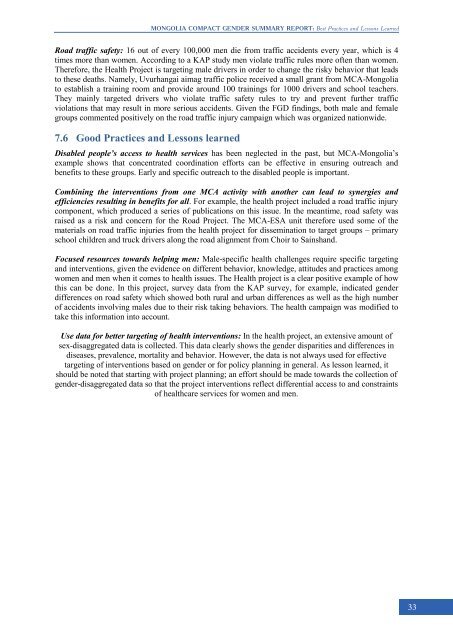Ulaanbaatar 2013
Ulaanbaatar 2013
Ulaanbaatar 2013
Create successful ePaper yourself
Turn your PDF publications into a flip-book with our unique Google optimized e-Paper software.
Mongolia Compact Gender Summary Report: Best Practices And Lessons LearnedRoad traffic safety: 16 out of every 100,000 men die from traffic accidents every year, which is 4times more than women. According to a KAP study men violate traffic rules more often than women.Therefore, the Health Project is targeting male drivers in order to change the risky behavior that leadsto these deaths. Namely, Uvurhangai aimag traffic police received a small grant from MCA-Mongoliato establish a training room and provide around 100 trainings for 1000 drivers and school teachers.They mainly targeted drivers who violate traffic safety rules to try and prevent further trafficviolations that may result in more serious accidents. Given the FGD findings, both male and femalegroups commented positively on the road traffic injury campaign which was organized nationwide.7.6 Good Practices and Lessons learnedDisabled people’s access to health services has been neglected in the past, but MCA-Mongolia‟sexample shows that concentrated coordination efforts can be effective in ensuring outreach andbenefits to these groups. Early and specific outreach to the disabled people is important.Combining the interventions from one MCA activity with another can lead to synergies andefficiencies resulting in benefits for all. For example, the health project included a road traffic injurycomponent, which produced a series of publications on this issue. In the meantime, road safety wasraised as a risk and concern for the Road Project. The MCA-ESA unit therefore used some of thematerials on road traffic injuries from the health project for dissemination to target groups – primaryschool children and truck drivers along the road alignment from Choir to Sainshand.Focused resources towards helping men: Male-specific health challenges require specific targetingand interventions, given the evidence on different behavior, knowledge, attitudes and practices amongwomen and men when it comes to health issues. The Health project is a clear positive example of howthis can be done. In this project, survey data from the KAP survey, for example, indicated genderdifferences on road safety which showed both rural and urban differences as well as the high numberof accidents involving males due to their risk taking behaviors. The health campaign was modified totake this information into account.Use data for better targeting of health interventions: In the health project, an extensive amount ofsex-disaggregated data is collected. This data clearly shows the gender disparities and differences indiseases, prevalence, mortality and behavior. However, the data is not always used for effectivetargeting of interventions based on gender or for policy planning in general. As lesson learned, itshould be noted that starting with project planning; an effort should be made towards the collection ofgender-disaggregated data so that the project interventions reflect differential access to and constraintsof healthcare services for women and men.Page 33 of 8033


